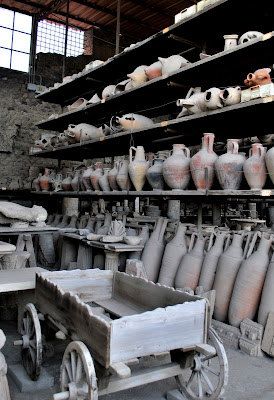THE BODY CASTS
The body casts were first made by late 19th century archaeologist Giuseppe Fiorelli. When Vesuvius rained pumice and ash on the town, bodies were trapped. Over time the bodies decomposed, but the cavities that had hardened around them remained intact. Fiorelli poured liquid plaster into the cavities, then when the plaster dried, he broke the pumice stone that surrounded it, leaving the world with over a thousand whole-body death masks of Pompeiian men, women, children and animals.
Body Cast - Man
Young Boy Covering His Face
Woman with child covering her face against the ash.
ARTIFACTS
Some surviving artifacts of every day life.
Trencher, table
EVERYDAY LIFE
The landscape holds many ruins that give a peak into everyday life in Pompeii.
Pompeiian Take Out. Vessels were filled with food offering for people to purchase or eat on the premises.
Storage vessels held and dispensed wine.
Bakery - Ovens
Bread Ovens
Water Spigot and Public Water Well
Women's Bath House
Women's Bath House
Phallic symbol indicating location of a Brothel. A welcome sight I'm sure for sailors in this seafaring town.
Next - Beautiful Florence














The penis pointers were the first thing my son told us about after he arrived home from his first art trip to Italy at 15. His art teacher had taken them to Pompeii. The other highlight of the trip was navigating his way around Italy from restaurant to restaurant -- he was in heaven, cuisine-wise!
ReplyDeleteMeri: I can totally agree with your son. Italy was indeed a culinary heaven.
ReplyDeleteThis is really wonderful tour around of such impressive archeological areas of Pompeii!
ReplyDeleteA place a have yet to go. Fascinating, right down to the brothel detail! :-)
ReplyDeleteJust amazing.
ReplyDelete